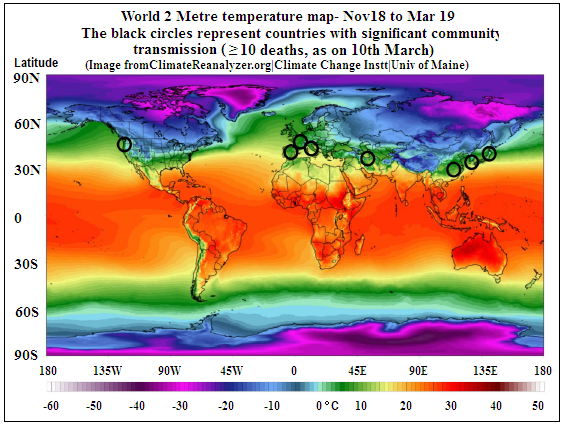Rigorous study shows that latitude or climate have no effect, says S.Ananthanarayanan.
There has been considerable expectation that spread of SARS-CoV2 would slow down, like its cousin, the common flu, when the weather warms
A study by Peter Jüni, Martina Rothenbühler, Pavlos Bobos, Kevin E. Thorpe, Bruno R. da Costa, David N. Fisman, Arthur S. Slutsky and Dionne Gesink, from St Michael’s Hospital, Toronto, the University of Toronto, a firm in Zürich, Western University, London, in Ontario and the University of Berne, Switzerland, published in the Canadian Medical Association Journal, concludes that this is a relief that we cannot expect.
In the third week of March this year, a study funded by the US National Institutes of Health reported that analysis of incidence of COVID-19 showed that community spread of the disease was limited to a narrow zone at latitude 30-50° N. The zone was initially seen to cover South Korea, Japan, Iran, and Northern Italy, and then Northwestern United States, Spain, and France. The places affected were seen to have consistently similar weather patterns, consisting of average temperatures of 5-11°C, combined with low levels of humidity. The study included graphics that showed areas of high incidence, on maps with colour coding of latitudes and temperature ranges.

The study said, “The distribution of significant community outbreaks along restricted latitude, temperature, and humidity are consistent with the behavior of a seasonal respiratory virus. Additionally, we have proposed a simplified model that shows a zone at increased risk for COVID-19 spread. Using weather modeling, it may be possible to predict the regions that are most likely to be at higher risk of significant community spread of COVID-19 in the upcoming weeks, allowing for concentration of public health efforts on surveillance and containment.”
The comparatively lesser numbers of COVID-19 positive cases in India, at the time, and in following weeks, held out a hope that the climate, among other factors, like Indians having received the BCG vaccine, the smaller proportion of over-60s in the population, would help India make a good showing. The current study, in the Canadian journal, however, says that measures of reducing mobility and social distancing may prove effective, but it is unrealistic to expect any help from the climate.
The study covered 375,609 cases, spread over 144 geopolitical areas with significant incidence, worldwide, as on 10th March 2020. China, South Korea, Iran and Italy were excluded, as the disease had progressed in these areas and figures may not reflect accurately the trends of spread as the disease took hold. The study then compared the cumulative tally of cases as on 20th March and 27th March, arising from numbers exposed during the week, 7th to 13th March, 14 days earlier.

“It is unclear whether COVID-19 is also seasonal and climate-dependent, but many of the suggested explanations for the seasonality of influenza may also be applicable to COVID-19. Evidence for seasonality and climate dependency of COVID-19 would have implications for public health and health care resource planning,” the study says. Analysis of data, like numbers of cases per million population, would not be meaningful, as these are influenced by travel activity, social behavior, when the infection first came, etc. “Comparing the current rate of reported cases with the rate of cases reported a week earlier is likely to be more helpful,” the study says. We can see that this corresponds to the ‘days taken for numbers to double,’ a popular metric used to describe the rate of spread.
The study uses latitude as a criterion because changes in the main components that distinguish summers from winters – temperature, humidity and the level of ultra violet radiation – would generally follow changes in the latitude, as the days and nights are of equal length in the month of March, in the northern hemisphere.
The collected data was hence analysed, primarily, based on the latitude, and as secondary factors, on the temperature and the humidity. Further factors considered were social action that had been taken, viz, closing down of schools, restriction of mass gatherings and social distancing, during the exposure period. Rigorous methods to assess the dependence of the data on the different factors and the ‘p value’ a statistical indicator of the significance of the data in holding that a given hypothesis is true or false, was worked out for the different factors being considered.
The ‘p value’ indicates the probability of the relationship that we are looking for turning out to be false – ie, that what statisticians call the ‘null hypothesis’ to be true. Now, when the data of the ratio of the number of cases detected two weeks after a period of exposure, to the number of cases when starting out, was analysed, in this mathematically sanitized manner, the result was high p value for the effect of latitude and temperature and a moderate value for humidity, but low p value for the effect of closing schools, forbidding mass gathering and maintaining social distancing. That this contradicts the findings of the earlier study is clearly because the previous study was comparing absolute numbers, which, as the Canadian study says, “are affected by idiosyncratic processes.”
That the social measures are effective has been widely recognized and these measures are the central thrust of strategy, worldwide. The Canadian study, to identify and validate the factors seen to affect the spread, is a valuable guide to states to steer clear of any expectation of relief during the warm period. The world is battling an attack that redoubles with a moment’s slackening on our part and the defense has to be guided by clinical adherence to what science advises – other considerations, economic, cultural or popular, may lead to disaster.
------------------------------------------------------------------------------------------ Do respond to : response@simplescience.in-------------------------------------------